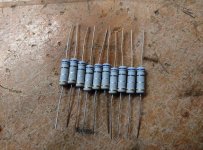So its the Newtronics, not Alps version.
Some other things:
When it is running what is the voltage on pin 11 of the IC ?
You could disconnect R7 from pin 11 and connect it to B+, turning off the output transistor. If the output transistor is ok the motor should not be running, if it is running the output transistor is defective.
With motor current a voltage is developed across R10, 0.68R, but in general, without the motor not stalled, this is likely not enough to exceed the base-emitter voltage of TR1. When the load is such that the TR1's b-e voltage exceeds about 0.65V, TR1 conducts and robs base current from TR2, lowering its emitter & collector current and thereby lowering the TR1's b- e voltage, so a "current limited equilibrium condition" exists where TR2's current ( the motor current) I is limited to I= 0.65v/0.68 Ohms, or about 1 Amp. Likely this limiting only happens at motor stall or motor start when the shaft is not rotating and generating emf, and won't normally be happening with the motor running. In summary, likely if that 0.68R resistor went high, it would limit the motor current to a lower max value and possibly slow it, not speed it up. If it went low, the motor start up and stall current would increase. However the current value in R10, manifest as the voltage across R10, during running, is fed back to the IC as well.
The Tacho coil feedback circuit provides speed stabilization. The feedback circuit of R8,C6 & C7 is sent back to the IC to pin 10 &12. The voltage across R10, being proportional to the motor's current, is used to generate artificial torque and help prevents the motor slowing down due to mechanical loading and frictional forces.

